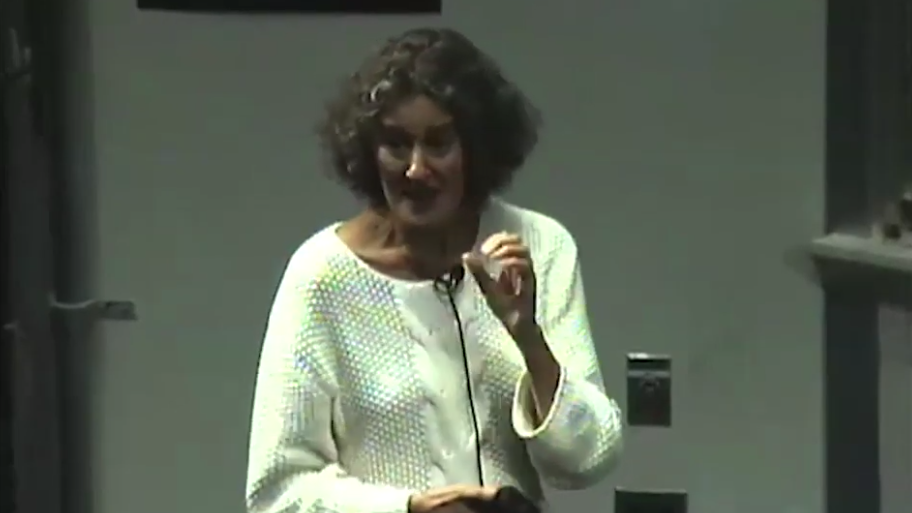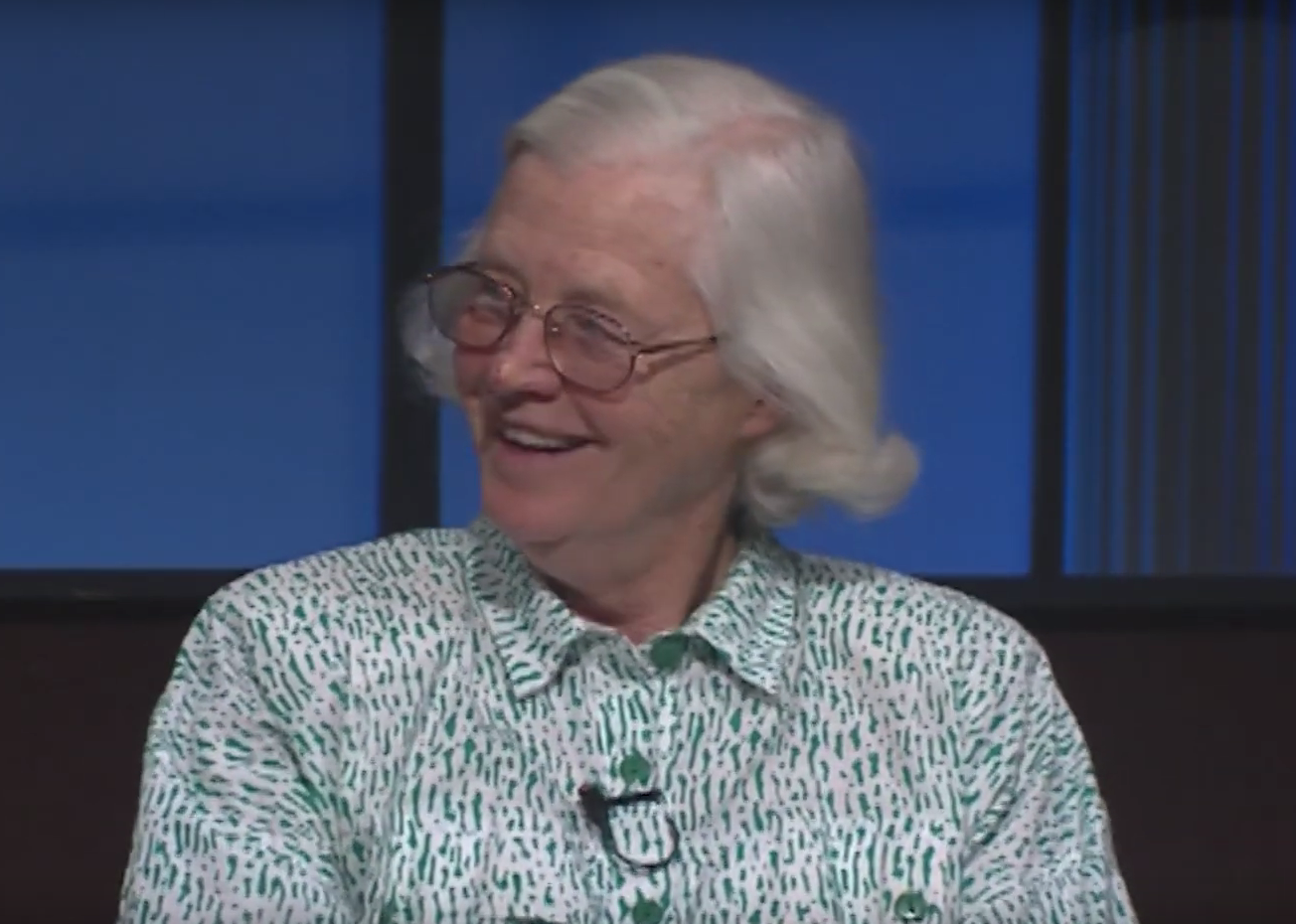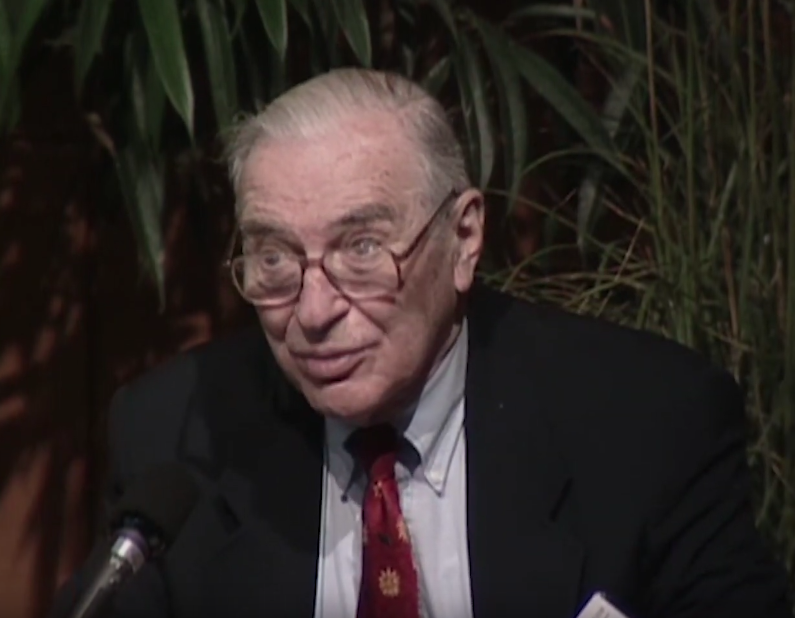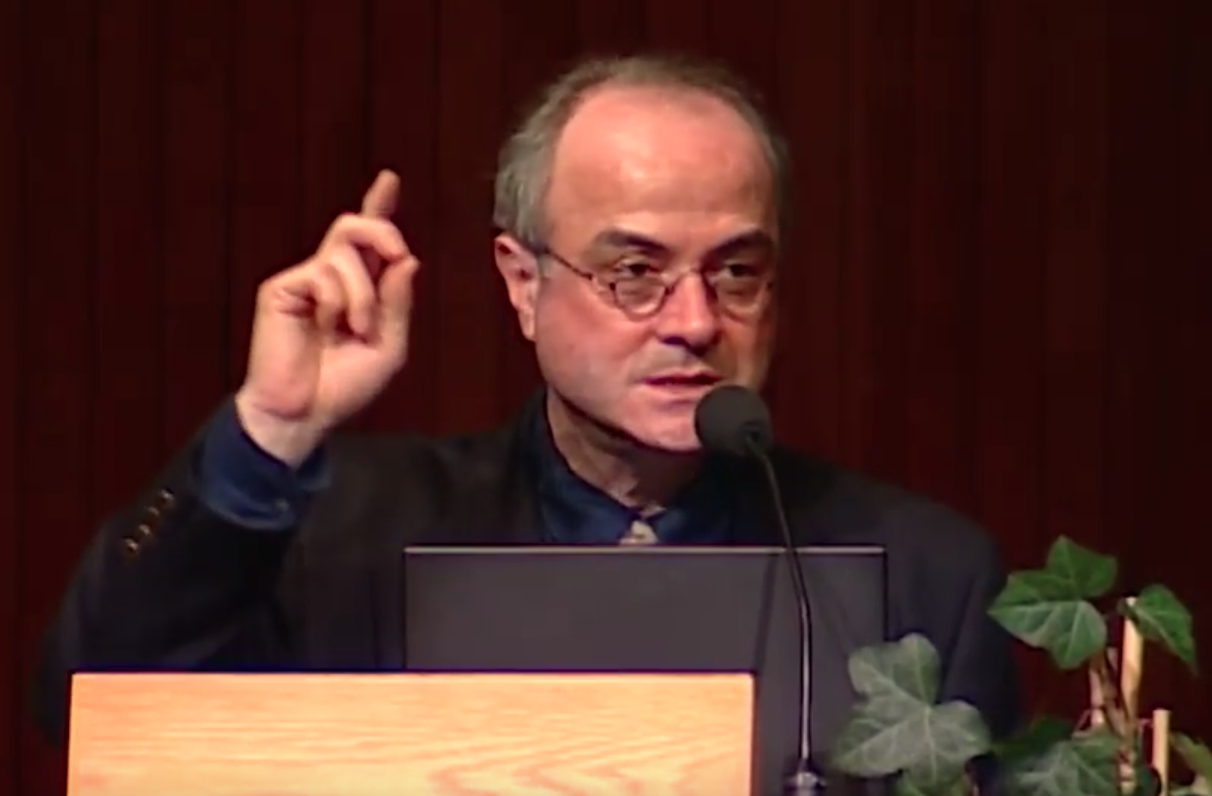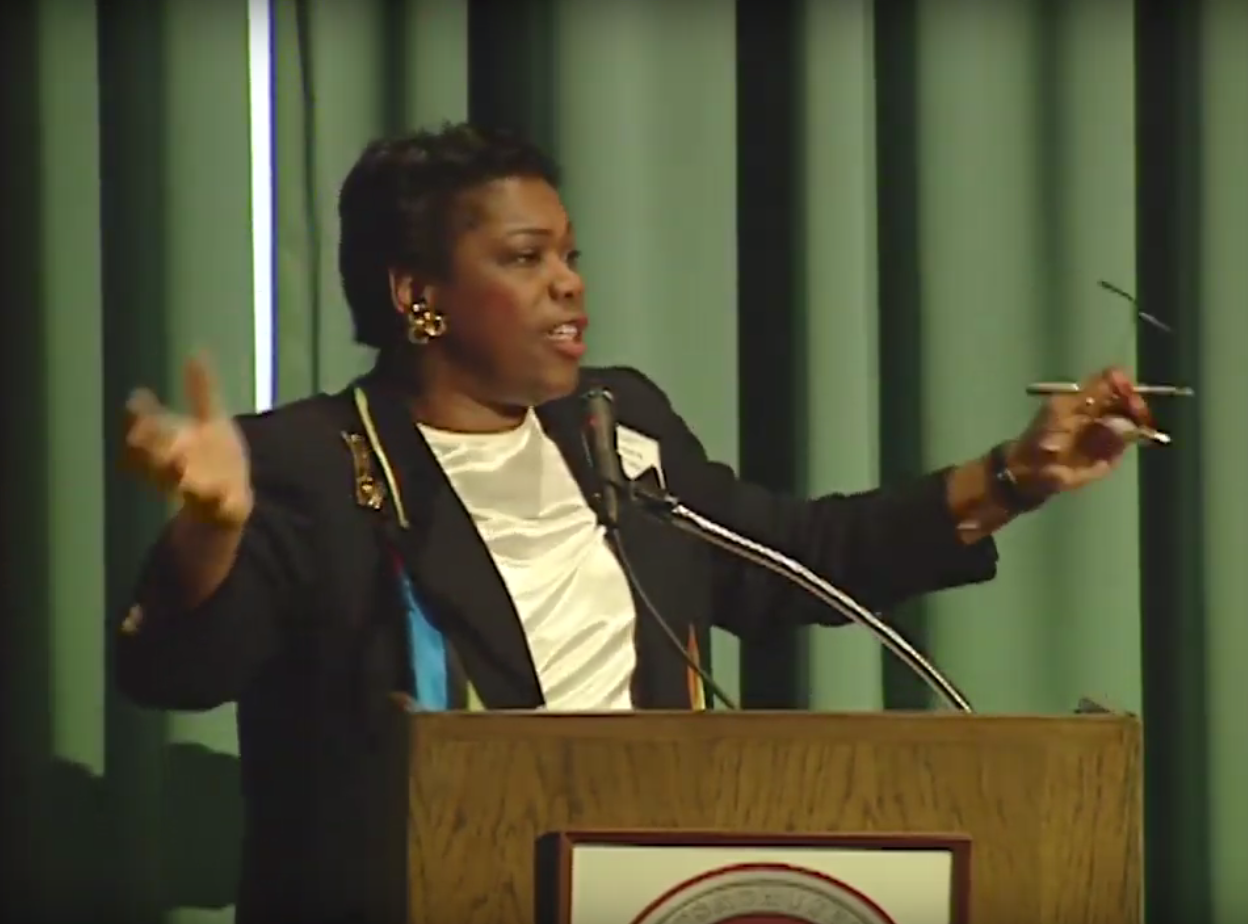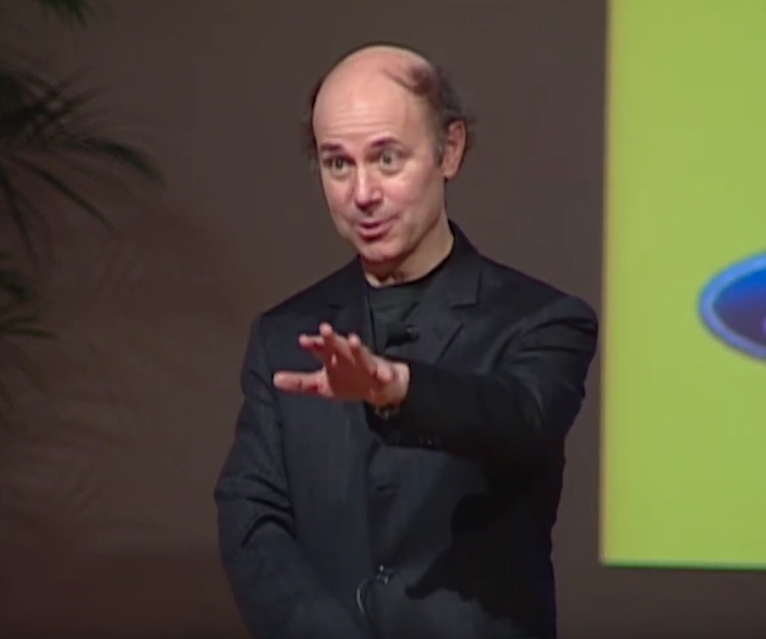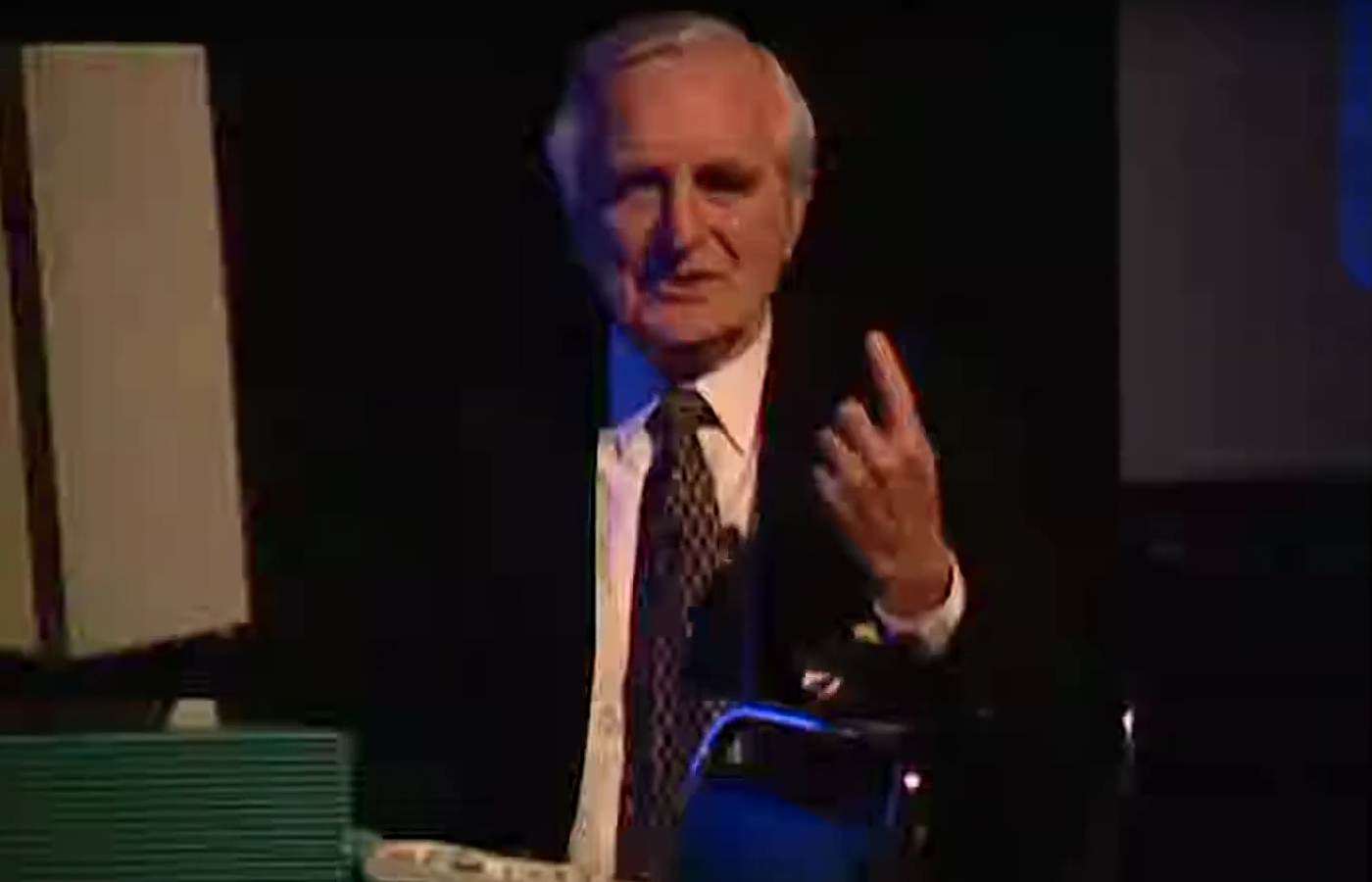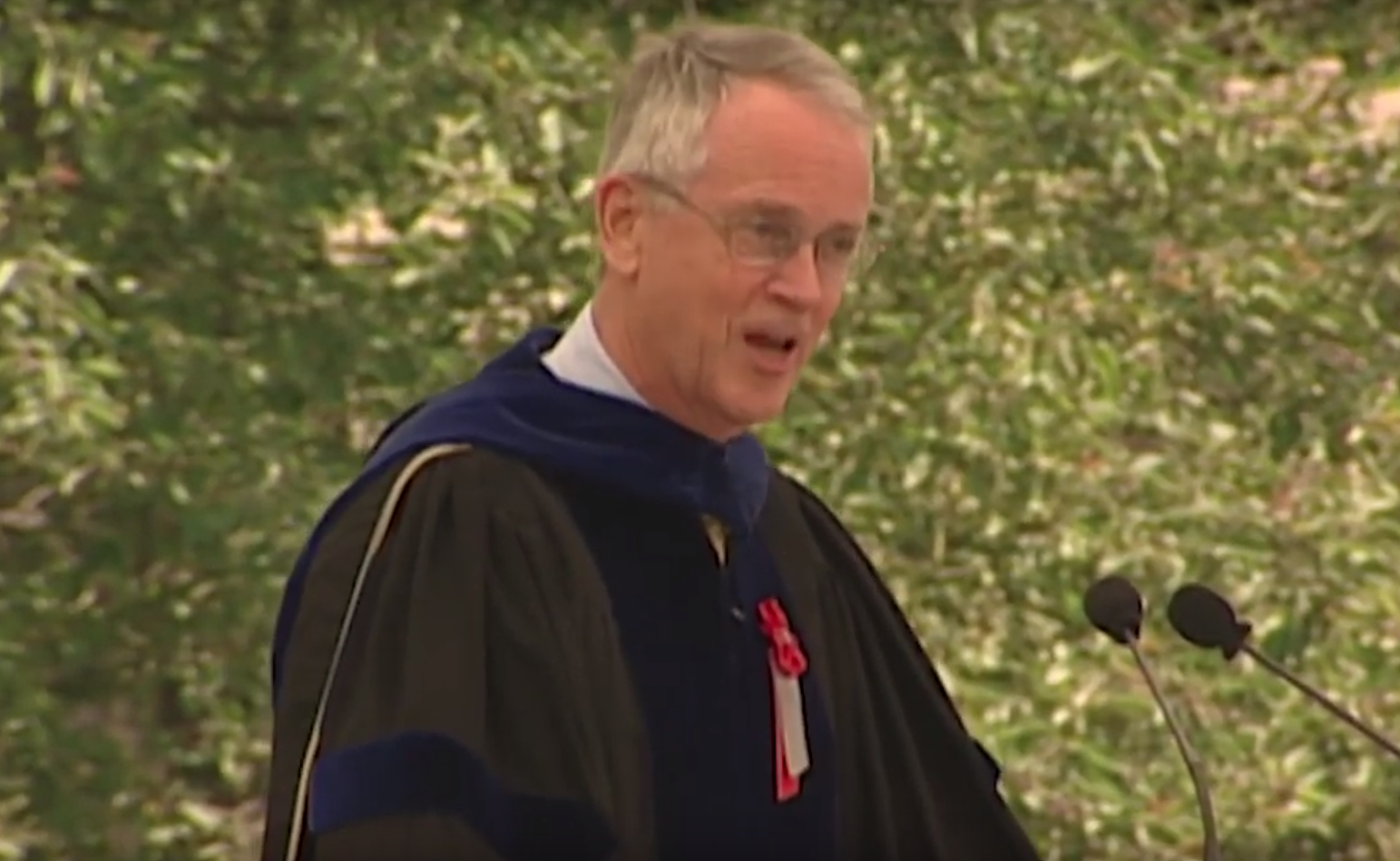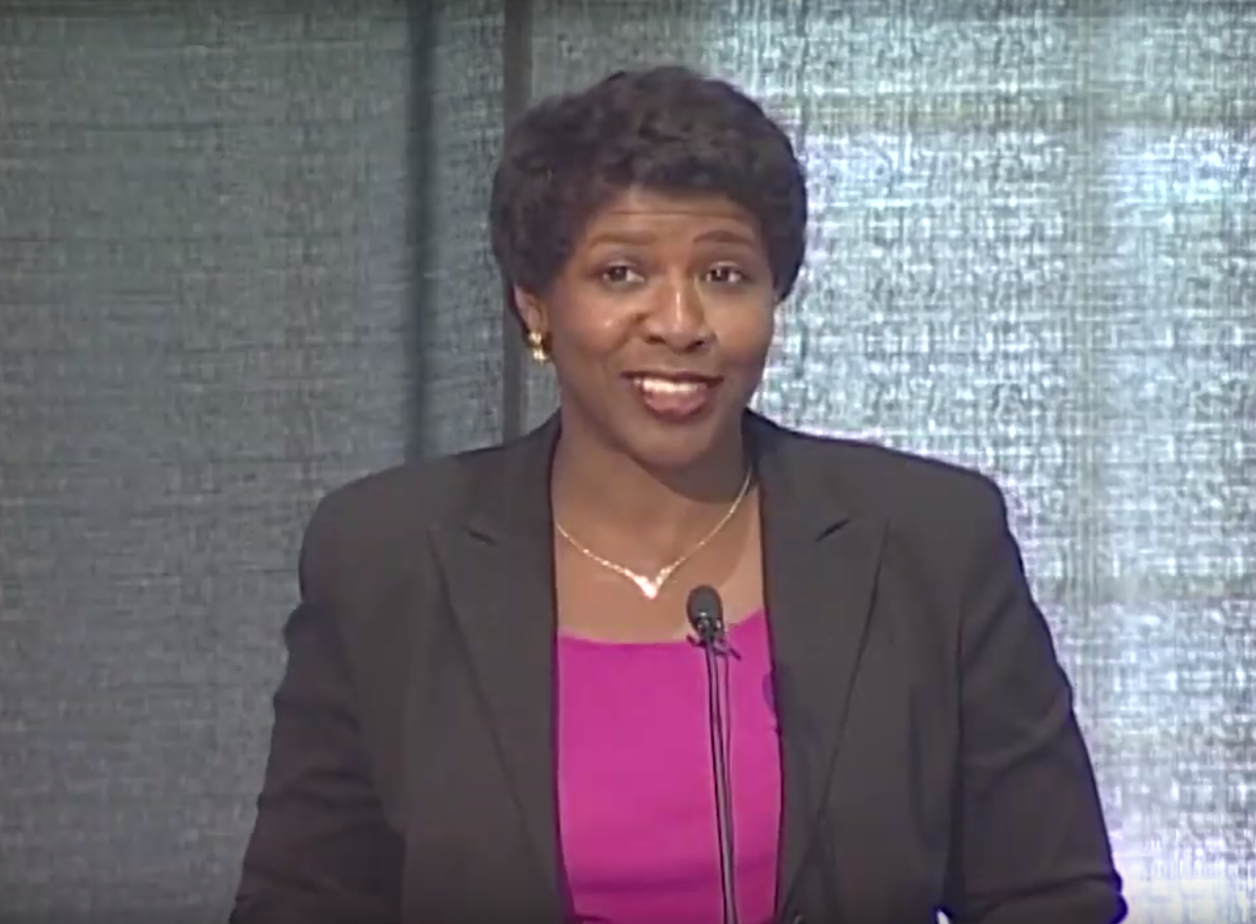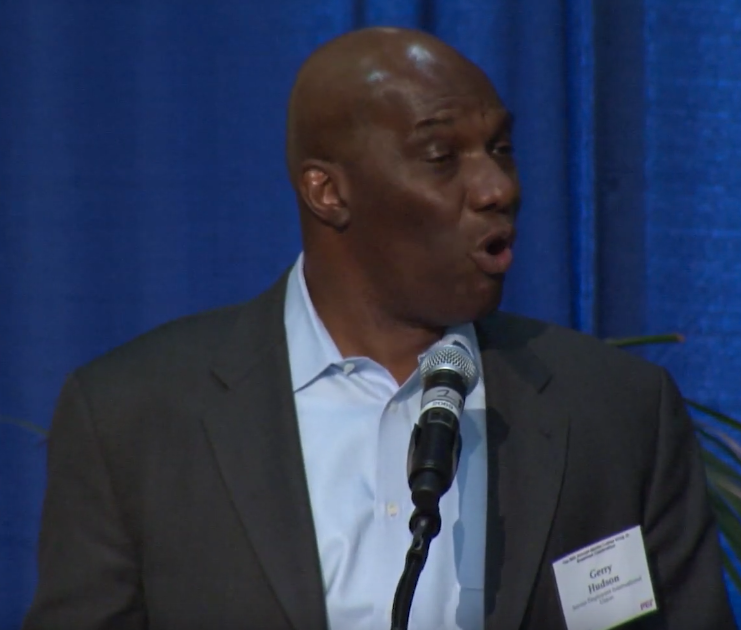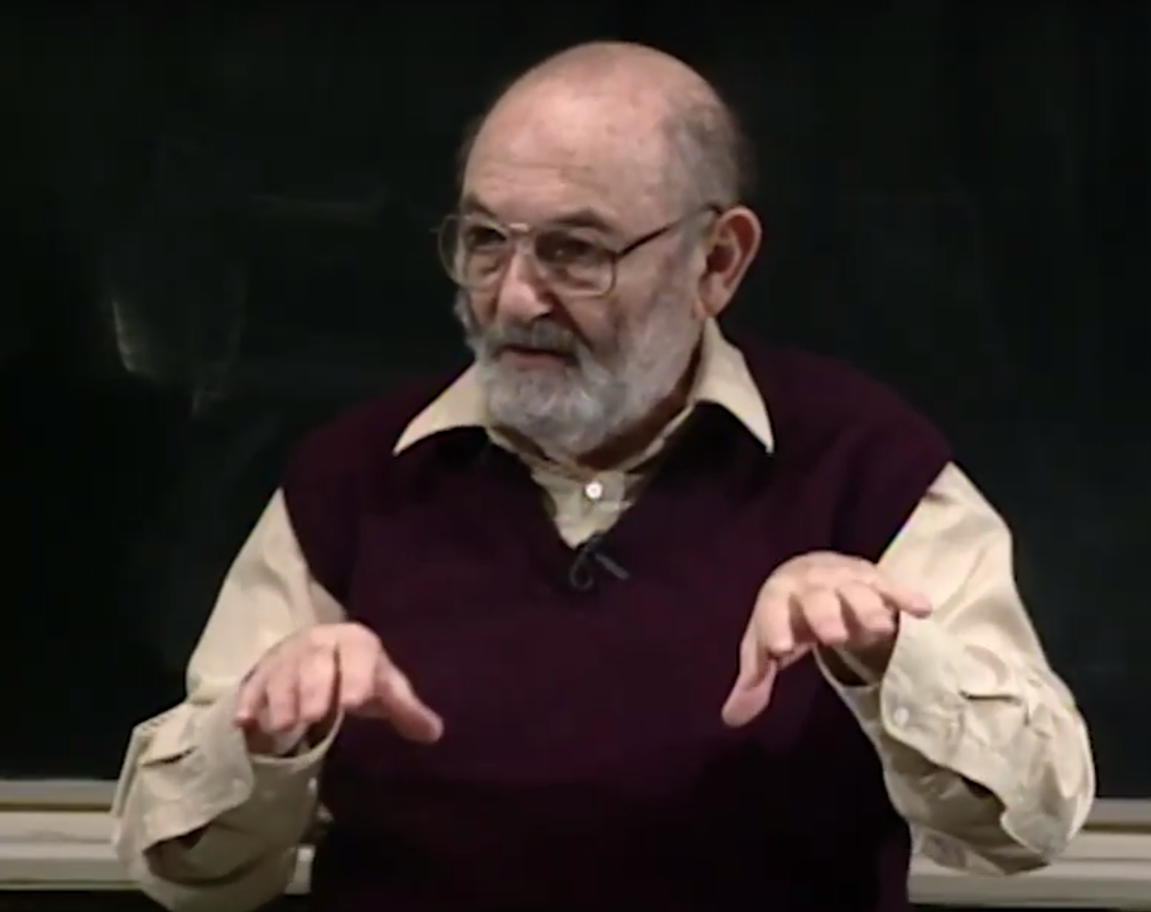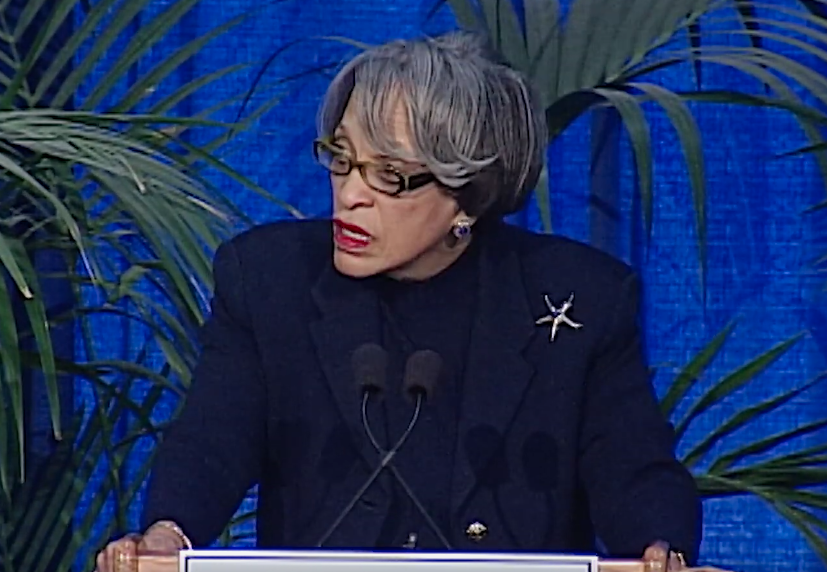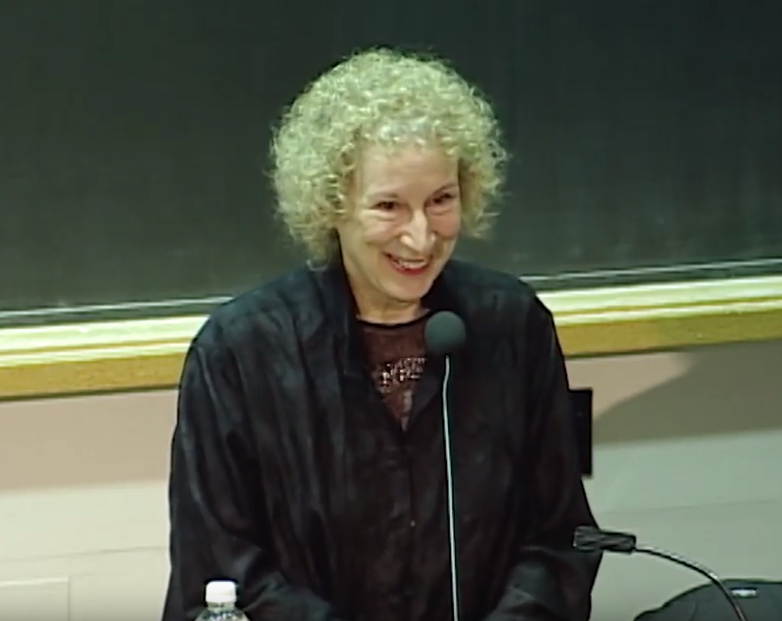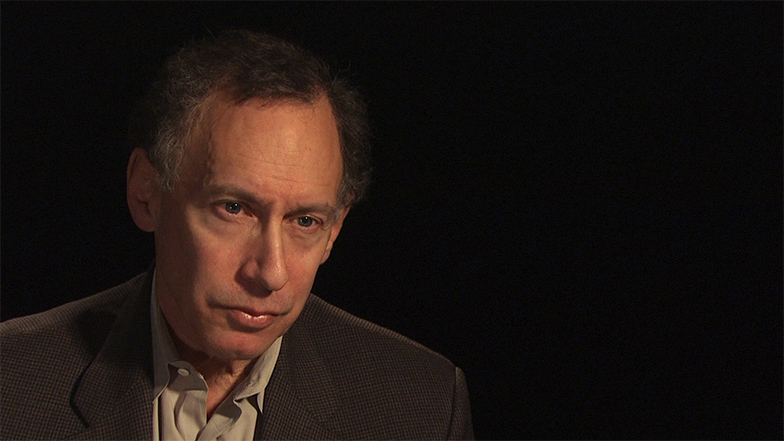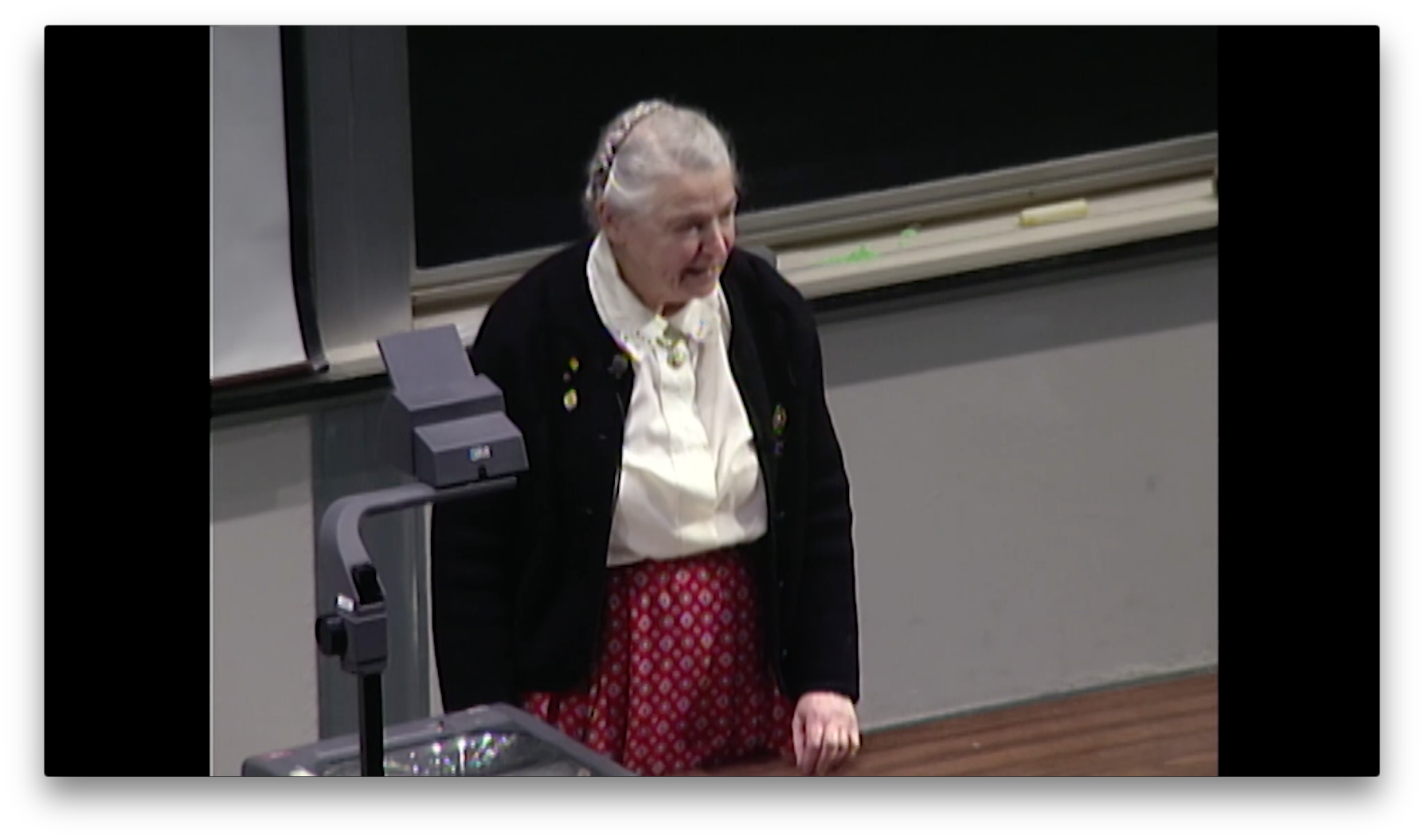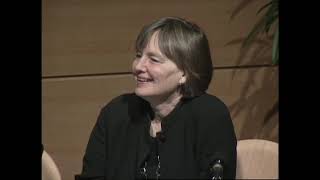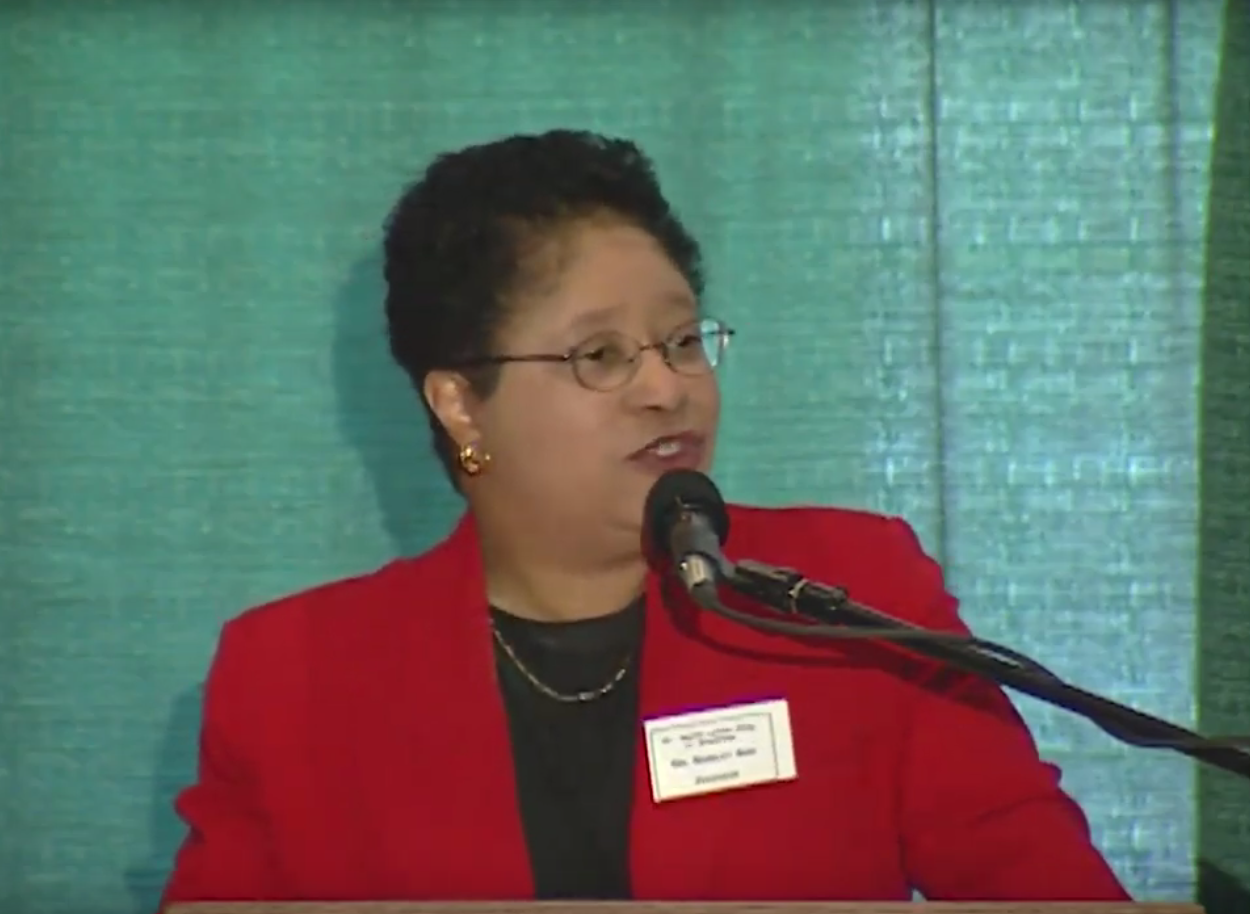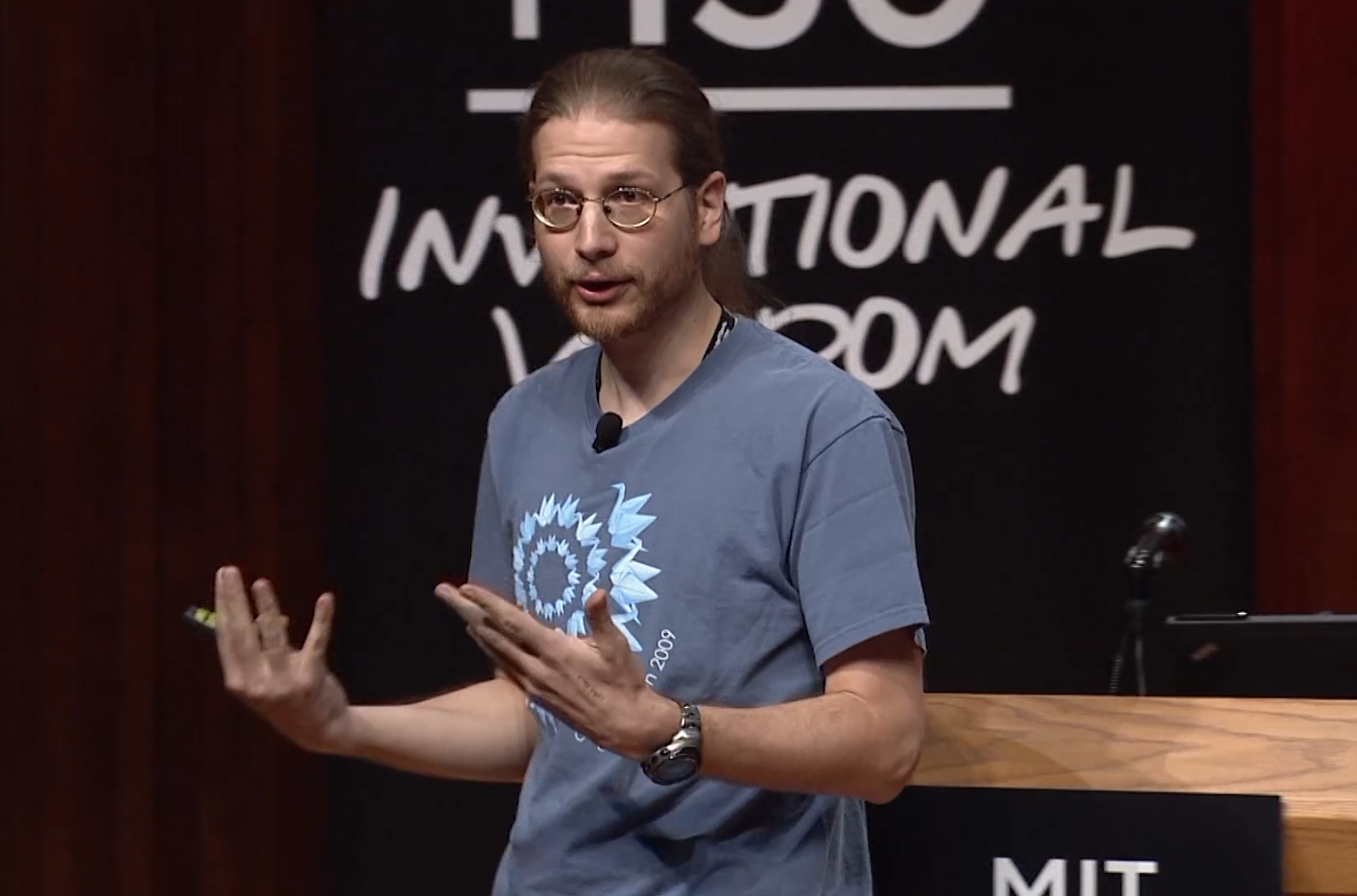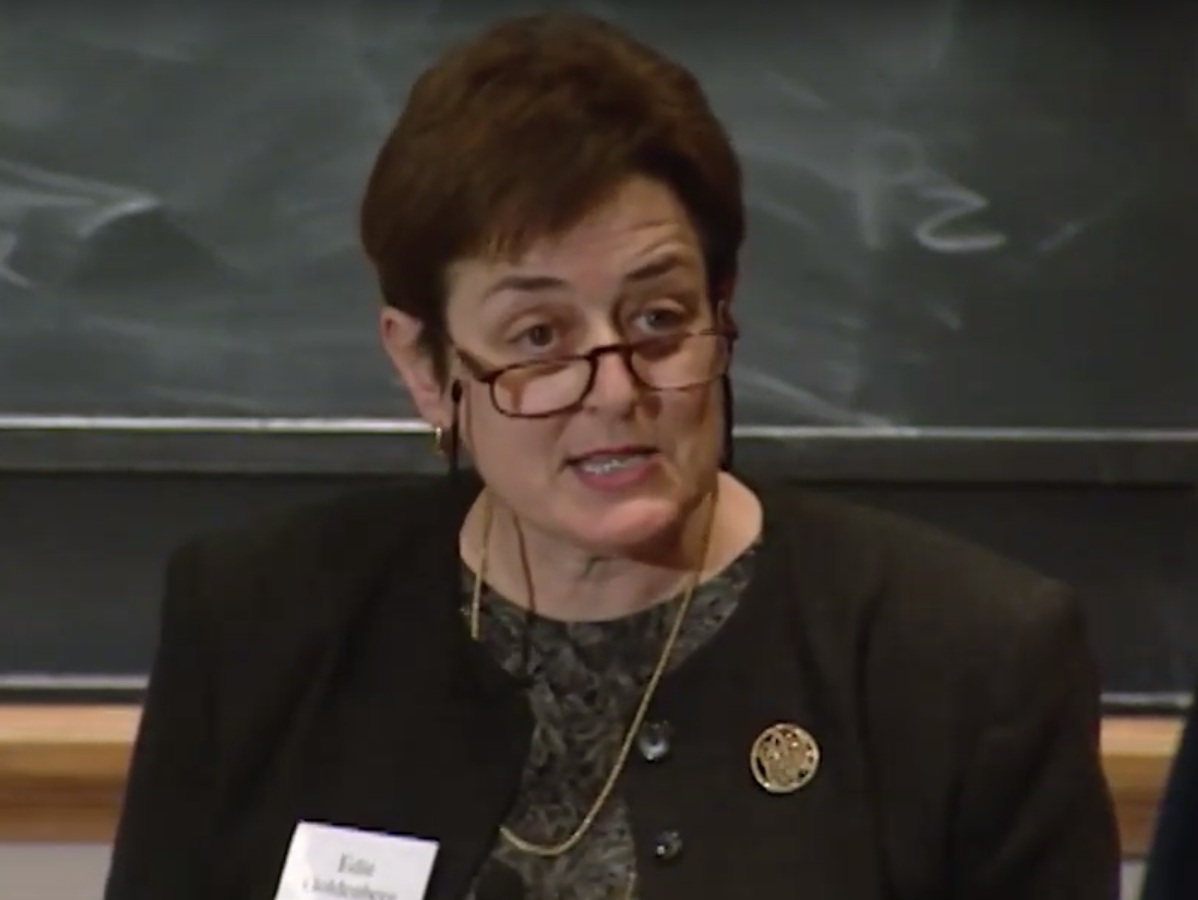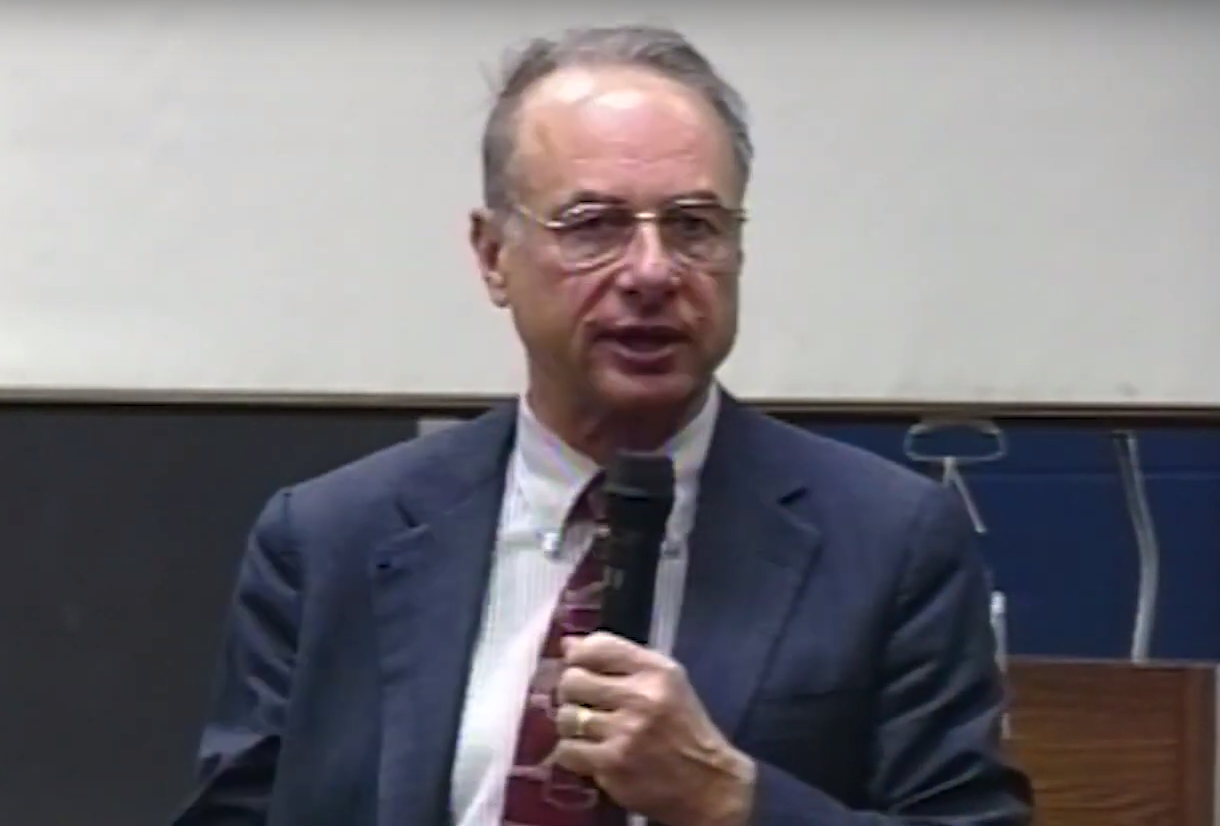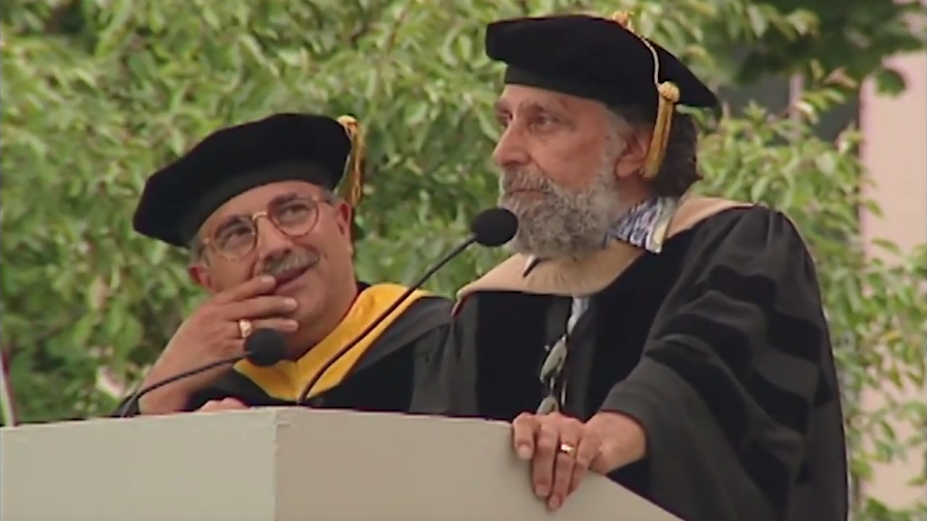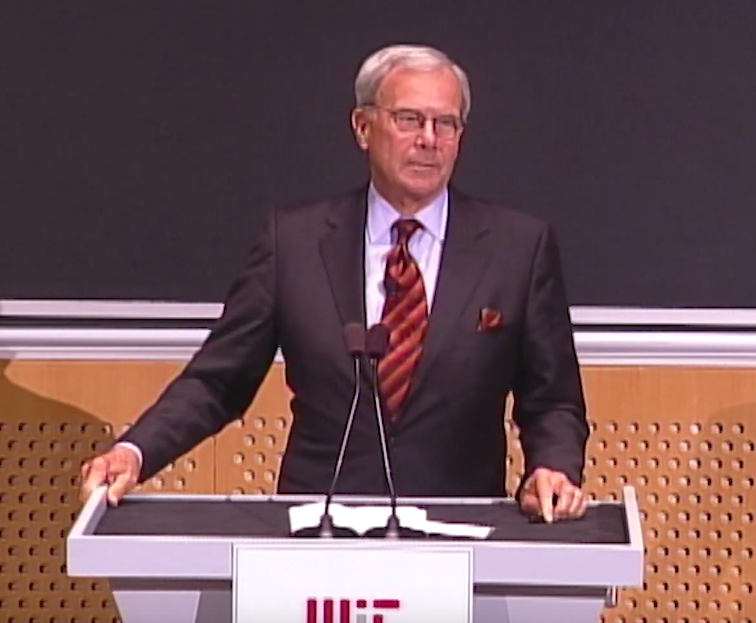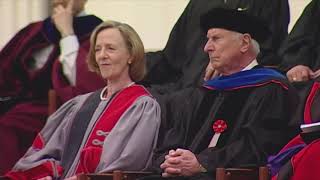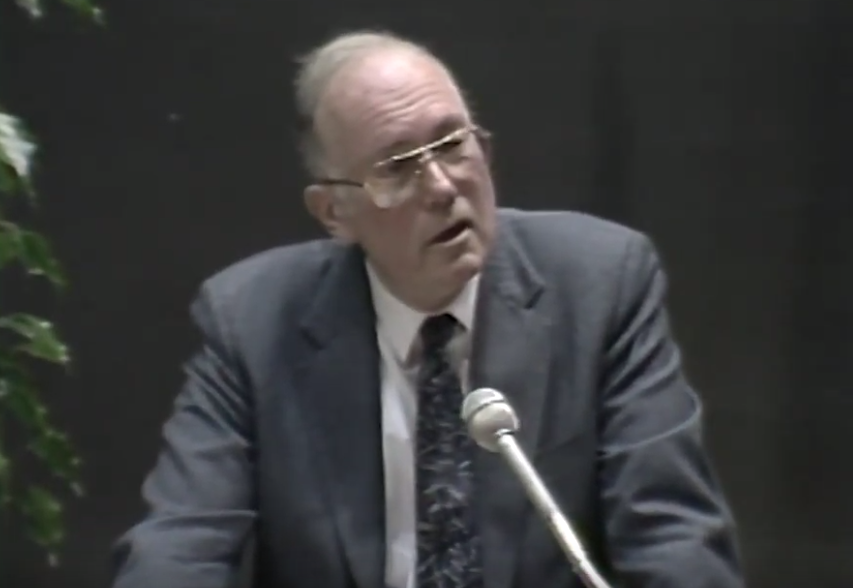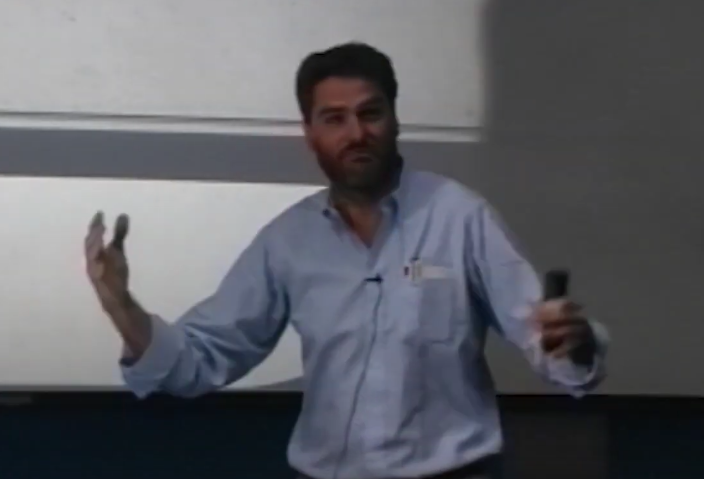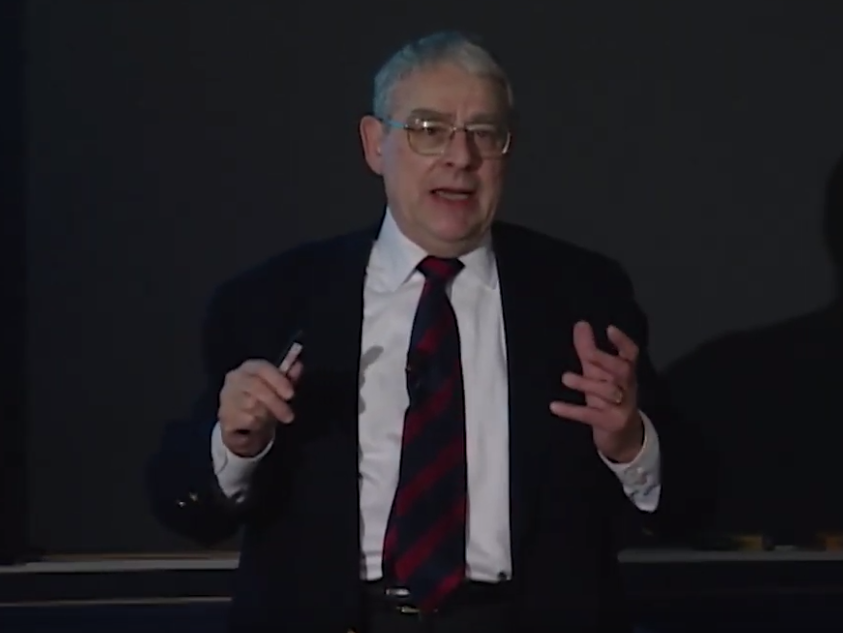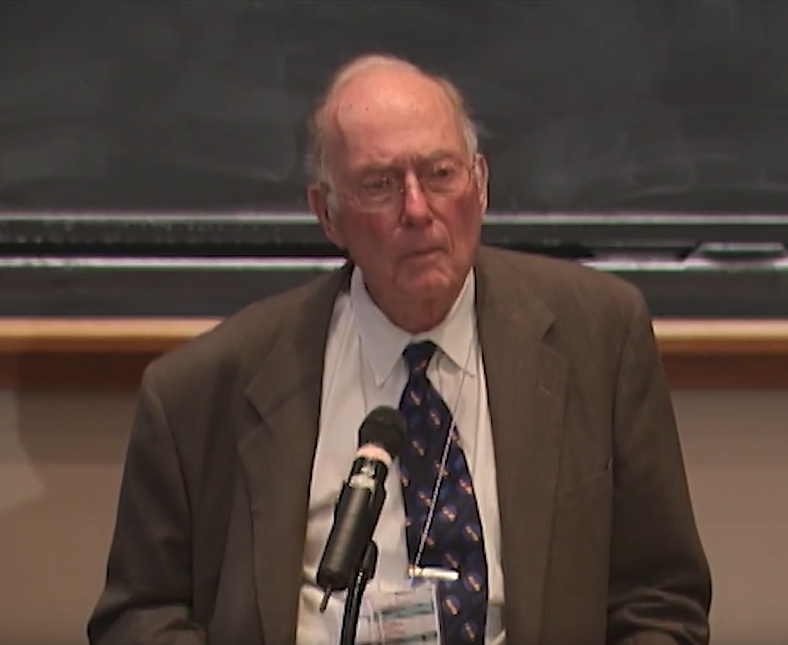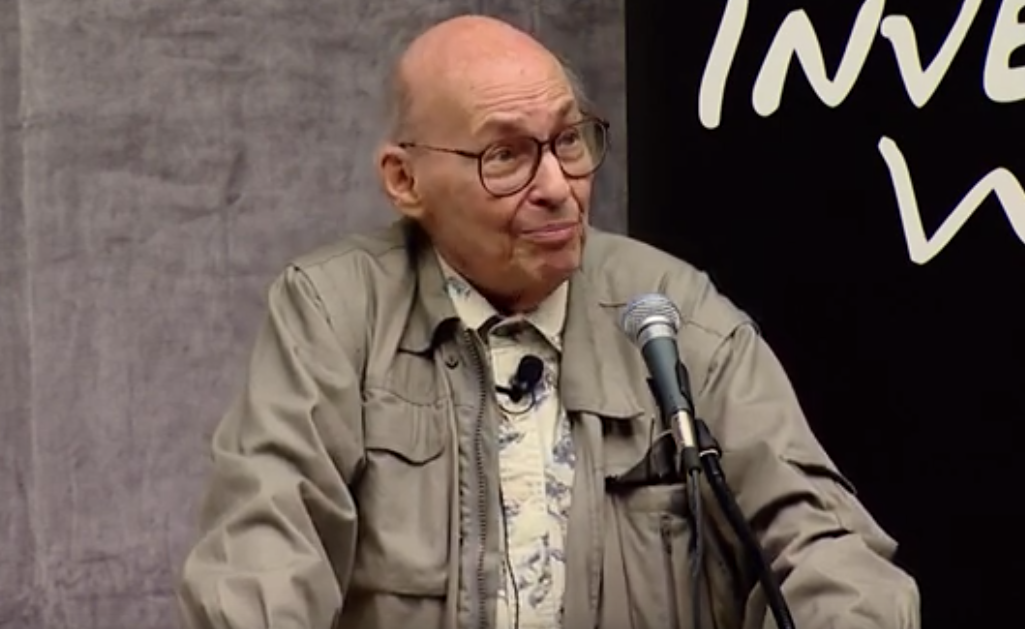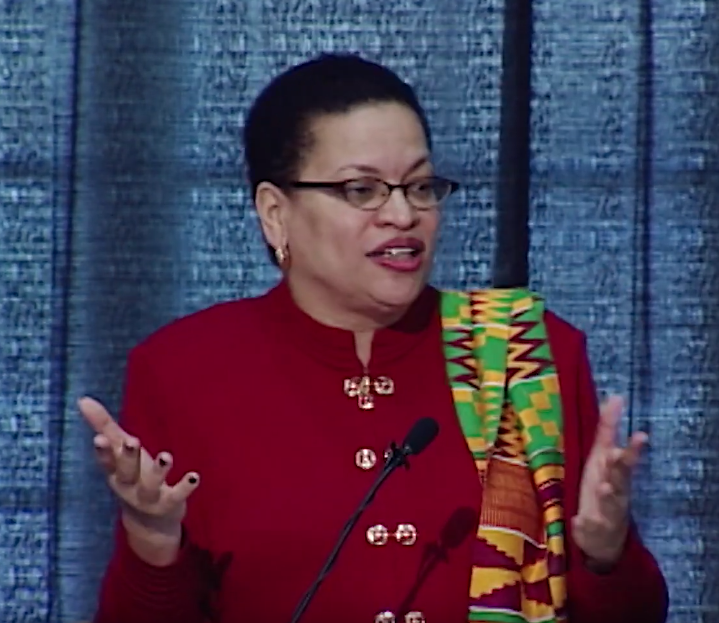Physics Open House Symposium: “The Importance of Basic Research in Physics and of MIT Science,” Session 1 (10/5/2007)
[MUSIC PLAYING]
MODERATOR: Thank you very much, Bob. Good morning. As the new department head of physics, I'm delighted to welcome you to this celebration of physics at MIT in connection with the dedication of our new Green Center for Physics. Physics is the science of energy, matter, and their interactions.
- Today, we celebrate the energy and vision of our faculty and staff, especially Marc Kastner, Bob Jaffe, and Shawn Robinson. We thank our generous donors, especially Neil and Jane Pappalardo, Virgil Elings, and Jim and Sylvia Earl. We thank Susan Hockfield and the Institute for bringing the Green Center Project and the PDSI Project around it to completion.
The efforts and dedication of many people brought forth a partial unification of the physics department that began as a dream about 30 years ago. Today, we also celebrate the origin of new mass, not the Higgs boson, not yet, rather the new infill Building named "6C" in MIT parlance and the transformation of matter in the surrounding buildings comprising the Green Center.
The Green Center now provides a focal point for many departmental activities and a home for about one fourth of our faculty. Today, we celebrate the increased interactions, especially those among and across our theory groups made possible by the New Green Center for Physics. This is an exciting time and place to be a physicist. At this juncture of departmental history, it's appropriate to survey the broad panorama of MIT physics, our contributions to science, our place in the national and international stages, and our prospects for the future.
We're delighted and very fortunate to have today, this morning, the reflections of four distinguished physicists with MIT connections. I'd like to thank them for coming. I'd like to thank our staff led by Gretchen Pullman for organizing and running this tremendous enterprise. And I would like to thank each and every one of you for coming and sharing with us in this celebration of physics. And now, I'd like to turn the baton to Professor Dan Kleppner, recent awardee of the National Medal of Science who will introduce our first symposium speaker. Thank you.
[APPLAUSE]
DAN KLEPPNER: So it's a great pleasure to welcome and introduce Charlie Townes. In the physics community the name Townes is synonymous with the maser and the laser. And those devices have had a transformative effect on large areas of science and on society and on my own career, because without the ammonia, maser-- there would not have been a hydrogen maser, and that's what launched my career many years ago.
Also, he had a transformative effect in another sense. He was the provost of MIT when I came here and played a role in my coming to MIT. And he also played a role in the transformation of MIT because in those days, MIT was known primarily as a school of engineering. Now, it's known as a school of science and engineering.
And the emergence of science as a major feature of the MIT life is due in no small part to Charlie's influence in those days. Since then, he has devoted himself to his love of radio astronomy and astrophysics. But his career has also been marked by large areas of public service. He was one of the original officials of the Institute for Defense Analysis. He helped to set up JASONS.
Over the years, he has advised the government on innumerable problems for which wisdom and technical knowledge were required. So in my mind and the mind of people who know him, that Charlie Townes is a role model for what's very best in physics. And we're very pleased that you're here with us today, Charlie.
[APPLAUSE]
CHARLES TOWNES: Well, I'm absolutely delighted to be back here at MIT. It's been a little over 40 years since I was here.
[LAUGHS]
And the place has change some. On the other hand, great memories still with me. And I'm delighted to just meet with you in celebrating the Green Center. This is a very important center, and it's kind of indicative of what MIT is about and what we hope it will be.
It is right in the middle of the campus and bringing together theorist and particle physics, solid state physics, and so on and hopefully bring together all of physics together. Now, this is an important aspect of science and technology. It's an important aspect of MIT. MIT has been great in uniting science and technology.
That's extremely important to our societies. It's extremely important to the advance of both of those fields-- both of those, very, very, very broad areas. And this center will help continue to strengthen MIT and these important fields.
Now MIT, of course, has a-- already had an enormously important role. I just counted up recently, MIT has 15 Nobel prizes on its faculty, many of them in science, wide variety of fields and in science and training. It's been just such an outstanding place for our country and for the world.
I want, particularly, to emphasize importance of basic research, importance of basic research and, hence, of this new center and of the department and also the MIT. There's enormous payoff. Not only does it help us in our understanding of our universe, our philosophy, so on, our thoughts, but it's very important to also to our technology and to our economy.
Now, in fact, one of your Nobel laureates, Bob Solow, who some time ago, says, "for every dollar of products sold by the United States, less than one penny is invested in research and development. But research, I assume, has much more than 1% effect on the final product. So economically speaking, investing more in scientific research is sensible."
He was one of the first to point out this, one of the first economists to point this out strongly. As I say, not only does it help our economy, but it advances us culturally and helps us understand philosophically what we're all about. Now, basic research gives us many surprises, and we never know what's going to be there. And this is one of the problems, particularly with our politicians and financial people.
You know, just why is this about some basic research? You can't say what it's going to do. Now, truly, you can't say exactly what it's going to do. But we know historically it's done wonderful things, remarkable things. And they come about suddenly and surprisingly.
I just want to mention two technological things you see, which is to say, well, the technology, it'd come out of basic science, yes. I was at Bell Telephone Laboratories when the transistor was invented. And my friends were Brattain, Bardeen and Schockley And Brattain, he was examining the resistance of oxide on copper wires. He was examining that, just studying it.
He found a funny effect. He couldn't understand it. Now, this is another example of the importance of interaction between different fields. He went to his friend, John Bardeen, who was nearby. And Bell Labs had all these people together, you see.
John Bardeen's a theorist-- said, what in the world is going on? And John Bardeen looked at it carefully and thought about it. He says, hey, you've got amplification. You've got amplification. Did you realize that?
No, no, no, well for goodness sake. So they, of course, patented it. And Bill Shockley was another theorist, was a [INAUDIBLE]. And he added some more things to it and thus came about the transition. Now, just think about what effect the transistors had on us? This result of trying to study the oxide, properties of oxide on copper water of all things.
I might mention also the laser. Now, I was working on microwave spectroscopy, and that was giving a lot of interesting science. And getting a very high spectral resolution, I wanted to get higher and higher resolution, but in higher frequencies, because in most spectral higher frequencies-- and I wanted to get down, oh, down the wavelengths a millimeter or shorter than a millimeter, down in the infrared if possible. I kept working on and thinking about how in the world can I do this?
Now, here's another example of the connection between science and engineering. You see, I've been at Bell Laboratories and had a good experience with radar and engineering and feedback oscillators and so on. Well, not so many physicists had that kind of experience, but I also, because of the physicists, I knew some quantum mechanics.
And I kept thinking about how can we possibly get the shorter wave lengths? I can't build oscillators that small. We can't make them that small with any power in them and so on. Well, of course, molecules and atoms give the exact frequencies, but well, you have to heat them up to get high-intensity radiation. And you have to heat them so hot that they then fall apart-- too bad.
And I was sitting on park bench and said, hey, wait a minute, wait a minute. We don't have-- they don't have to be described by a temperature. We can put them all on the higher state. Oh, oh, boy. And I wrote it down, and put out an envelope from my pocket and wrote down the equation. Oh, looks like it worked.
[LAUGHS]
It was very exciting. Well, now, this required feedback, of course, and oscillators. And many of my physicist friends didn't think it was very practical where it wouldn't work very well. In fact, the chairman my department said, oh, stop working on that. That's not going to work. You know it's not going to work. It's a waste of time, wasting department's money. Well, fortunately, I had tenure, and then I could say, no, I'm going to continue.
[LAUGHTER]
So it worked. We built the first what you call a [INAUDIBLE]. It was a first, we'll make it operate in the microwave region, which I knew all about, and I could make it work there first, and then I'd go on to shorter wavelengths. Getting shorter wavelengths was difficult. And with our channel with Bell Telephone Laboratories, we decide how to get on the short wavelengths and make a laser. And when the laser came along, again, people thought, well, okay, that's a nice idea, but what good is it?
[LAUGHTER]
What good is a laser after all? Well, I could foresee some things. And even the Bell Laboratories' lawyers, who we suggested patent it. They didn't see any point, and said, well, light had never been used for communications. We don't think Bell Laboratories' interested in patenting it, and--
[LAUGHTER]
--so I told [INAUDIBLE] don't going to go back to them. Tell them, yes, it can be used for communication. So they said, well, okay, if you're sure how it's used, used in communication, we'll patent it. So well, now, you see the resistance to new ideas we've got to have new ideas and our society has to be open to them.
And that's what you people are doing. And that's what physics is doing, basic science and new ideas, things that break open new things. And the laser, of course, is a multibillion dollar business now. And people said, oh, yes, it's a nice idea, but what good is it? Well, it turns out to be several years of this.
[LAUGHTER]
In fact, I'm just delighted how useful it is. And now you may know, one of the very first gas laser was built by Ali Javan here at MIT. I came to MIT shortly after that. And Ali Javan built the very first gas laser. And then went on a nonlinear optics, was another new field, nonlinear optics, which also produces a lot of new science and a lot of new technology.
Now, the United States has generally done pretty well in science and technology. And then the percent of our GDP, which we invest in it, is a little bit larger than the percentage that Europe invests. It's not as large as what Japan invests, little bit larger than what Europe invests.
Nevertheless, we publish somewhat more papers per person in the United States than the Europeans do. In fact, you want the numbers? We published 809 papers per year per million people, whereas Europe publishes 639. Japan publishes 569. So we were doing substantially better.
And our technological exports, well, let's say our technological exports as a share of total manufactured products. United States is about 29%, whereas in Europe, it's about 20%. So we're doing-- we've been doing well. On the other hand, recently, we've been sagging, and I think we must recognize that. We've got to speed up. We've got to speed up. Europe and Japan, Europe, particularly, is going to get ahead of us.
Example, the fractional share of publications back about 15 years ago, we were publishing 38%. Europe, preparing and publishing 32%. Now, they are publishing 38%. We're publishing 32%. So we're going downhill compared to Europe.
And they're putting more into it. And they recognize importance of it, and we've got to recognize the importance. We've been so successful at it, I think, maybe we're a little overconfident. And I think we must recognize, our public must recognize, and our politicians must recognize, we must all recognize the importance of basic research, the importance of the interaction of different fields.
And here, MIT is a great place-- the interaction in different fields. And your department has many different sections, but I know science and engineering interact there strongly, and that's enormously important-- importance of those interactions and importance of different field, importance of basic research, importance of new discoveries, unexpected discovers. And as I say, that's the problem, and we must emphasize that the public.
We must keep giving them examples and so on. You have to keep at it, because it's difficult to say, well, I don't see what's going to come out of this. No, we can't predict what's going to come out of it. But we know historically that a lot of wonderful things do come out of it, and they pay off enormously, enormously. And so we want to keep going.
Now, there are lot of-- also a lot of fascinating new fields and fascinating fields, and they're not all new, but fascinating fields in the physics these days. Cosmology just think cosmology-- what cosmology is doing, and it affects our philosophy, our thinking and so on. One of my students, Arnold [? Pendges, ?] was looking-- again, you'll see surprises-- he was-- he did a theses with me looking for hydrogen in interstellar space.
He didn't find it. He went to Bell Labs. He kept looking. He didn't find it. What did he find? He found radiation from the big bang of the origin of the universe, discovered the origin of the universe of all things.
Now, we know it had an origin, which surprised all physicists. It happened only 13 billion years ago. Universe was small. It blew up-- fantastic. And that affects our philosophy and our thinking.
And so this cosmology-- and cosmology is just a fascinating field now. And there's, well, a lot to be learned. Then there's nanoscience-- nanoscience and nanotechnology. The very big and the very small--
[LAUGHS]
--this exciting field. Biophysics is a great field now. And then there's so many puzzles, dark matter. The great majority of the matter in the universe, we don't know what in the world it is. 95% of the universe, we don't know what in the world it is-- dark matter and dark energy.
What is it? We can see some of its effects, but we can't really see what in the world it is. What could be less important, finding what's most of this universe made of?
[CHUCKLES]
What to do with. And then there's all kinds of new puzzles and new things. How did it begin? The apparent discrepancy between quantum mechanics and relativity, how did matter form and so on. If you go still further, then think about free will. How can we possibly have free will?
So there's all kinds of fascinating and puzzling problems for us. Well, I want to finish by thanking very much the Greens and the other people who have contributed to this great establishment. Congratulations to all of you for the new building, and very best wishes to MIT, the personnel. The students, and for the new scientific insights. Thank you.
[APPLAUSE]
PRESENTER: So I'm looking for Patrick Lee, who is there. So Patrick from our Condensed Matter Theory Group, which we in particle theory are delighted to have within shouting distance, will introduce Shirley Jackson.
PATRICK LEE: OKAY, well, I think many of you know Shirley Jackson from her pictures, which MIT proudly displays along the Infinite Corridor. And it's a thrill for me today to introduce you to the real person. So while Shirley, of course, was there, real MIT product. She was an undergraduate here and also a graduate student. She received her PhD from the Center for Theoretical Physics in Particle Theory in 1973.
And after a few years, she decided that she wanted to-- she wanted to change fields and become a condensement of theorists known as [INAUDIBLE] physics in those days. And so she went to Bell Labs, and I happened to be working at Bell Labs at the time. And so soon after she arrived, we started collaborating and became good friends since then. And well, since Shirley has a history in both particle physics and condensed matter physics, so it's very, especially appropriate for her to address us today because while part of-- one of the goals of the Green Center is to bring these two communities together.
So while Shirley was making a name for herself in research, first in Bell Labs and then at Rutgers, another side of her, great talent, began to emerge. You see, even folks from these very early days when I first met her, she has shown that special leadership quality that are very apparent. She won't hesitate to speak her mind on issues that concerns here deeply, be it signs, sign policy, or social issues.
And when she speaks, she speaks with great eloquence and conviction. This talent did not go unnoticed. Shirley was appointed by President Clinton to head the Nuclear Regulatory Agency in 1995. And she became the president of the Rensselaer Polytechnic Institute in 1999 where she still has that position today.
Throughout her distinguished career, Shirley has maintained close ties with MIT. She served as a life member of the MIT Corporation and on our Visiting Committee, the physics department. Today, Shirley is recognized as a national leader in science policy and education. She has received many awards. And the most recent one is selection by the National Science Board as a recipient of the Vannevar Bush Award. That's another MIT connection.
For quote, "a lifetime of achievement in science, scientific research, education, and senior statesman like contribution to policy, public policy." unquote. So let us welcome Shirley Jackson. She is going to speak to us on "Science the Endless Frontier, the Continuing Relevance of Vannevar Bush."
[APPLAUSE]
SHIRLEY JACKSON: Well, good morning. I'm told that one is known by the company one keeps. And so to be included on the panel of speakers is a great honor. Now, it is no secret that I have a great attachment to MIT. I did receive all of my degrees here, all two of them. I spent the formative years of my young adulthood here. And as a life member of a corporation, the MIT corporation, I get to help steward the university today. So my reverence for MIT is profound and strong.
But most of all, I revere the transformational ideas, which regularly germinate within and around this great place and the living presence of these ideas in our lives, in our society, in our nation, and throughout our world. Now, may I say as we celebrate the opening of the MIT Green Center for Physics, these ideas cannot but better germinate with the inspired design and building adaptation achieved here? I must say when your new chair talked about the idea of being around for 30 years, I remember that.
[LAUGHTER]
And creating a core center for the study of physics, particularly uniting condensed matter theory with particle and nuclear theory, strengthens the academic community and importantly strengthens the physics department and fosters a productive cross-fertilization of ideas. None that, needless to say, it is also considerably more convenient for students and faculty and easier to administer. Now, I'm delighted to be at this dedication because Cecil Green, of course, was MIT alumnus, a life member of the MIT Corporation and great benefactor.
Now, J. Erik Jonsson was an RPI Alumnus trustee and great benefactor. He was a co-founder with Cecil Green and Eugene McDermott of Texas Instruments. And he was the mayor of Dallas and brought that town back together in the aftermath of the assassination of President John F Kennedy.
Now, having received my doctorate in theoretical elementary particle physics here, now my own career has led me, as you've heard, to positions in government, industrial research, and academia. In each of the sectors in which I've had the privilege to work, I have found a vision and overall guidance in the work of a distinguished MIT alumnus and professor. Dr. Vannevar Bush-- now, as you know his seminal work, Science, the Endless Frontier, has helped to shape science policy in this country for more than six decades.
And if we, I believe, continue to adhere to its basic principles, we will see a continuation and a revitalization of the unprecedented era of discovery and innovation, which our previous speaker so eloquently spoke to and which has benefited our quality of life and our national security, but importantly has enhanced life for people around the globe. Now, I said that Van Bush was a MIT alum, but actually he was a 1913 graduate of Tufts University. But then he entered graduate school at MIT and received his doctorate in electrical engineering jointly from MIT and the place up the street called Harvard in 1917.
Now, during the last year of World War I, Dr. Bush worked at the National Research Council improving techniques for detecting submarines. And while he was there, he observed a lack of coordination between civilian scientists and the military. And he began to formulate his ideas about the interrelationships among scientists in the government, academic, and industry sectors. And later, he returned here to MIT, joining the Department of Electrical Engineering a professor where he was from 1923 to 1932, becoming vice president and dean of engineering from 1932 through 1938.
And while here, he built a mechanical analog computer designed to solve differential equations with as many as 18 variables using wheel and disk mechanisms to perform the integration. This was before the invention of the discovery of the transistor effect and the invention of other things. Now, one of his grad students was Claude Shannon and another, Frederick Turman, who was instrumental in the genesis of Silicon Valley.
Now, in 1939, Dr. Bush assumed the presidency of the Carnegie Institution of Washington, which supported intramural research and awarded scientific research grants to researchers at other places. And subsequently, he held a series of federal scientific research titles. Now, throughout much of the 19th century, I have to tell you, federally sponsored scientific research had been centered at federal establishments such as the Smithsonian Institution, the US Geological Survey, and a network of agricultural experiment stations established by the 1887 Hatch Act and was charged with conducting research to improve American agriculture.
Now, scientists at universities, on the other hand, were involved in advanced scientific research funded primarily by private donors, philanthropic foundations, state legislatures, and, of course, student tuitions. Now, during the period between World Wars I and II, the science community expressed skepticism, even some antagonism toward the concept of federal funding. Their experience of conducting research within a university environment fostered their allegiance to academic freedom. And they feared that government funding might lead to government control and the relinquishment of intellectual freedom. But singular events shift paradigms.
And World War II was really a war of science and technology in which military strategy and technology developed in tandem. And with the war's onset, Dr. Bush convinced President Franklin D. Roosevelt that the United States needed an all out mobilization for defense based on collaborative scientific research among the different sectors. Science was mobilized under civilian control to assist with strategy and to develop technological measures to improve allied tactics and effectiveness. Scientists evaluated military problems and developed devices and weapons to resolve these problems and to oppose enemy tactics.
Let me just tell you about one, because it says something actually about the ingenuity of people in those days before quantum science came to be. The German V-1 or what was known as the Buzz Bomb, powered by an Argus pulsejet, terrorized, and devastated London. And this first guided missile used a simple autopilot, which was really a weighted pendulum to provide for an aft attitude measurement to control pitch. And it was damped and stabilized by a gyromagnetic compass.
A countdown timer on the nose driven by a vain anemometer was set according to prevailing wind conditions to reach zero upon arrival at the target. But these were effective as area bombs. And the characteristic buzzing, which ceased moments before these bombs struck and exploded, terrorized and psychologically demoralized the people in London.
Now, allied countermeasures included antiaircraft fire, but the V-1 speed and altitude were more than the rate of traverse of the standard British, what was called QF 3.7 inch mobile gun. And there were a number of other methods that were only minimally effective, but the threat was reduced when more effective measures were developed. And these were electronic aids for anti-aircraft guns developed here at the MIT radiation laboratory or the Rad Lab, as it was called, which was still in existence when I came as a student.
And it was a division then of what was called the National Defense Research Committee under the leadership of MIT president Karl Taylor Compton and then, Dean of Engineering, Vannevar Bush. And these devices were based on the cavity magnetron, radar-based automatic gun laying and the proximity fuse. In addition, Bell Telephone Laboratories produced an anti-aircraft predictor fire control system based on an analog computer.
Now, you're already beginning to see the point I've been trying to make about this marriage of research universities, industry, and the government. And so as the war was drawing to a close at the end of 1944, President Roosevelt asked Dr. Bush to evaluate the lessons learned from the wartime mobilization of scientific expertise and how that might be applied to peacetime pursuits.
And so they were four advisory panels convened by Dr. Bush. And in July of 1945, Dr. Bush produced his strikingly prescient report, Science, The Endless Frontier, which he submitted to President Truman since President Roosevelt had died that April. Now, read in its entirety, the report is comprehensive. It sets forth a national intellectual roadmap focused on science.
But what most people didn't realize in balance with other national need for high ability in the humanities, the social sciences, and studies essential to national well-being. And it is a science policy model for knowledge creation and application encompassing the elements required for innovation, a blueprint for a new area of science. And the fundamental principles of Dr. Bush's report are simple. First, that the results of scientific research could be adapted readily to shifting national needs and could accelerate the pace of innovation, assisting not only in national security, but importantly in medical advance, economic growth, quality of life, and overall societal benefit. And Dr. Townes has told you some of the outcomes.
Now, Science, The Endless Frontier, set forth to the important dictum. One posits that basic science is performed without thought of practical use to derive fundamental understanding. A second offers that basic research discoveries will be converted and can be converted to become powerful drivers of technological innovation.
Now, the report's release made front page headlines in The New York Times. Now, do you think that would happen today? It probably wouldn't, but the results that that report drove have been dramatic and enduring. In 1935, the federal government contributed only about 0.35% of national income for research and development. By 1962, that investment had risen to more than 3.3% of national income, an increase of nearly 10 orders of magnitude. And since the issuance of the Bush Report in 1945, a science policy infrastructure has developed more or less in line with Dr. Bush's concepts and a science funding apparatus.
Now, there have been several differing yet identifiable periods in the decades since then that have affected science and reflect global events in US interests and concerns. The first, of course, was the Cold War period immediately after World War II. And this period was characterized by a robust investment in defense, space, and nuclear energy research. And that is where the genesis of high energy physics really came and concomitant, vigorous support for students in science and engineering and mathematics to pursue studies in higher education and beyond.
Now, a second period took place during the Great Society Program under President Lyndon B. Johnson, but it wasn't a great period for science because it was characterized by a dip in support for basic research. And instead, funding was focused largely on social priorities and public sector needs. There was one area where research support did increase, and that was for social and behavioral science.
Now, a third period developed in the mid 1970s when there was an increased interest in national economic competitiveness, and that was because of Japan because there were questions as to whether the US could compete seriously in engineering and manufacturing. And after the 1973 world oil crisis, Japan itself invested heavily in conservation and in reducing oil dependence and, at the same time, enhanced its productivity. Advances in microcircuitry and semiconductors led to new growth industries and consumer electronics and computers. The net result expanded knowledge intensive in service industries. But US concern over global competitiveness however, was short-lived when Japanese economic growth slowed.
So today, the context of the Vannevar Bush paradigm has shifted somewhat. And there is a greater call for public accountability, greater less discretionary funding and a narrower focus on short-term outcomes. Federal investment in scientific research has been shrinking, driven by concern over big government, the limits on federal spending, the federal deficit, and its growth, as well as more confidence in market-driven private sector research.
Now, the AAAS, of which I was president in 2004, the American Association for the Advancement of Science, estimates that overall, federal science research spending has declined by half as a percentage of GDP since 1970. Now, you know, 50 years ago, this week, I think, in fact, 50 years ago yesterday, we met the challenge of the Soviet launch of Sputnik by employing elements of Dr. Bush's paradigm in much the same way we did to win World War II. With the breakup of the former Soviet Union, however, there's no longer a Cold War with imminent thermonuclear standoff.
There are other nuclear threats, however. And the interesting thing is that the outcome of wars fought since that time have been determined less by opponents' advanced technology, but as much by cultural and other factors often beyond the scope of science and technology. And so today, 50 years after Sputnik, we sit with a need to focus on another great global challenge-- energy security and sustainability. And I believe it is the space race of this century. We are in a race against time, as we were then.
Success requires multiple sector collaboration as it did then, but it requires a base rooted in fundamental research with no product in mind. But research always seeds new ideas leading to yet unknown advances. And research, we should not forget, is important in its own right. But this will require rejuvenation on a massive scale of the university government industry mobilization in basic research and education, which powered our efforts in World War II and beyond.
Now, there was a recent law passed calling the America Competes Act that a number of different groups worked to have enacted. And I was part of one of those, actually two of those. One of them being a National Academies Panel whose report was entitled, Rising Above the Gathering Storm. And the legislation that was signed into law supports a comprehensive strategy to keep America innovative and competitive and focuses on K through 12 through higher education, but with a particular focus on energy.
Now, I am not going to spend the time to tell you everything that it is about, but it does authorize strong increases for the NSF as well as for other federal funding agencies. But the few-- the elements of the act really barely scratch the surface, but to the degree that appropriations meet authorization levels. It will begin to refresh the compact to rejuvenate its strengthen to develop more of you, new generations of scientists and engineers.
And today, Dr. Bush's model of multi-sector collaboration is being realized not only at the federal level, but increasingly in regional initiatives and at state levels as well. And of course, I have to tell you about one, being the university president. Last month, for example, Rensselaer opened what we call the Computational Center for Nanotechnology Innovations, which results from a $100 million partnership between and among IBM, Rensselaer, and New York State. And it makes possible a supercomputer that ranked seventh in the world in computational power. And it's the most powerful at any purely university in the world.
And it will generate more than 100 teraFLOPS of computational power and large storage. Now, but it's only a tool. But with its sheer computational power and with the ability to handle and manipulate massive amounts of data, this will support computationally-driven discovery and innovation across a broad front, including in theoretical physics, computational biology and chemistry, engineering design, climate change modeling, and more.
Now, our intent is to link this platform with another unique platform that we call the Experimental Media and Performing Arts Center. And because of its unique physical spaces and its technology, impact will be a technology-enabled creative arts program and platform. But it's a research platform as well because it will, as an umbrella, for drawing the arts, sciences, and technology together, it will allow unique performances when married with the computational power of the Supercomputer Center.
And you say, why? Well, it is our intent-- and I'm giving-- talking to you about this because of this link I've always found in scientists, especially physicists, between the science and culture. It is our intent to assemble the world's best orchestra or at a more modest level, the world's best string quartet to play in one of our spaces, in one of our studios, except they will not all be in one room. And to create the real-time, real presence, three dimensional experience with an audience in the room of dispersed musicians playing simultaneously together is its own research problem.
Now, but why did I spend the time to talk to you about this? Because this is about the Green Center for Physics. I talked to you about it because the kinds of things that people are trying to understand in cognition and learning in perception, in artificial intelligence actually have roots in the kind of thinking that-- and the actual work of that physicist.
Why did I spend the time to talk about Dr. Vannebar Bush at this symposium celebrating the New Green Center for Physics? Well, Dr. Bush's understanding that fundamental research powered by multidisciplinary collaboration to do great things is being played out here today in the Green Center, as you draw multiple sub disciplines of physics together in one space. And I can always remember I sat in this room for many lectures, by the way. I always sat where the gentleman in the yellow shirt sat, the middle seat of the second row so I could look the professor in the eye, but he usually didn't pay that much attention to me. He was busy writing his equations on the board.
But the real message is that one is always true to one's roots. And drawing disciplines together and sub-disciplines still, I think, is a paradigm for the advance of science. I also chose to do this because Cecil Green, like Dr. Bush, was a visionary. Because the success of the company that he founded, based on originally instrumentation for oils prospecting and drilling, required in an industrial framework, the same multi-sector, multidisciplinary approach we taught so much today.
But let me just close by telling you a little bit about my physics experience here at MIT. It was unique, and it allowed me, even at an early stage, to do basic research as an undergraduate as I'm sure many of you do. But even then, I was a bit of a contrarian who reached into other fields. In my case, materials, science, and engineering to combine the thinking in those arenas with physics to do my bachelors' thesis, which was on tunneling density of states in superconducting niobium titanium alloys.
And I remember one of my physics professor saying to me, well, you know, you've done pretty well here. In fact, you've done well enough to go to grad school here, but why solid state physics? If you wanted to do nuclear physics or elementary particle physics, this would be a great place for you. Well, stupid me, I stayed here anyway.
But I did concentrate in particle theory for my PhD, but I switched later to condensed matter theory when I had the chance, of course, to work at Bell Labs with great physicists like Patrick Lee and Maurice Rice who were my mentors when I first went to Bell Labs. But my physics experience at MIT has enabled me to do basic research in elementary particle theory at Fermilab and CERN to do condensed matter theory at Bell Labs. And in those days they'd hire you if you were smart enough, even if you weren't trained in condensed matter physics.
And there, I spent time studying the electronic and optical properties of two-dimensional systems, starting with charge density waves and layered transition metal dichalcogenides and moving on from there. And I told a good story about using studies that I had started doing on the topological properties of solutions to non-linear field theories and elementary particles that they would be applicable to something in condensed matter. And it turns out that in that problem I worked on with Patrick and with Maurice Rice, we actually did discover a topological structure that controlled the thermodynamics of the charge density wave system.
But I also been able to do science-based regulation and to help develop national and global safety policy, the policy, as chairman of the US Nuclear Regulatory Commission, which likewise enabled me to form an International Nuclear Regulators Association, which drew together the chief and heads of regulatory bodies in Canada, France, Germany, Japan, Spain, Sweden, the UK, and the US to work together to try to improve the global safety network and to work with countries of the newly independent states of the former Soviet Union to improve their safety and safety culture. Now, I must confess to feeling a little as though I have shadowed Dr. Bush all my life. Now, we share the MIT experience, but my career path through my positions in government industry, research, and academia parallels the essential elements of his life. Dr. Bush became a life member of the MIT corporation, as am I, and a Regent of the Smithsonian Institution, as am I.
But the real privilege for me was to receive the Vannevar Bush medal last spring from the National Science Foundation-- not National Science Board. Now, I did not know where my career would lead as I left MIT at an uncertain time. In fact, when I began graduate school, most of us were told we should kind of give it up, particularly in theoretical physics, but stupid me, I stayed on.
And so I left MIT armed with my bachelors and PhD degrees in physics, and my life and career have unfolded in ways that I could not have predicted, but it has been an exciting journey to this point. And that is the real beauty of an MIT education, of an MIT physics education, which reflects the beauty of physics, itself. Thank you for inviting me.
[APPLAUSE]
PRESENTER: If it's all right with the first two speakers, we actually have some time for questions from the audience if any of these stimulating ideas have raised them. Surely, Virgil.
VIRGIL: Well, Professor Townes mentioned three things-- I think, [INAUDIBLE] writing down-- the laser, the transistor, radiation, all of which were my ideas. They were actually sleeping with their eyes open to seeing something different than what they taught. How do you educated people too see thing different than what they think they're doing?
CHARLES TOWNES: Well, I think that's why MIT should be an illusion, I think, they do. But keep your eyes open to go and explore. Think about things to explore. Try out new things and so on-- open-mindedness. How to do this? I don't know, but every professor has to imagine his own ways.
[LAUGHS]
AUDIENCE: Or whatever [INAUDIBLE] say. I know other people have seen this. They just don't believe it.
CHARLES TOWNES: [LAUGHS].
I'm familiar with that. Go ahead.
SHIRLEY JACKSON: Oh, I would to like comment on that if I could. I think MIT has a unique way of educating students because it actually challenges them. Things are not textbook-based even in traditional courses.
And it certainly allows students to explore open-ended problems through research. And I think what one really does is one does not create creativity; one nurtures it. And I think that's what the education here is all about.
CHARLES TOWNES: Students should not necessarily believe their professors.
SHIRLEY JACKSON: Absolutely.
[LAUGHTER]
CHARLES TOWNES: Questions?
PRESENTER: It's very hard to convince students that they should tell their professors they're wrong, but that's the first step. Other questions? Anybody want to raise a point? Okay, well, I have a question principally directed at Shirley, but anybody can answer this, I think.
Shirley, you painted a picture of a time when government interaction with basic science was very optimistic, and the collaboration that grew out of that was incredibly productive. Many of us feel like, in the present generation, we live in some kind of world that is a fantasy creation where the government speaks openly in political discussions about science, contradicting the basic laws of science, and ignoring the advice of good scientists. Do you have any advice about where we went wrong and how to solve that problem?
[LAUGHTER]
SHIRLEY JACKSON: Now, you're asking me a political question.
[LAUGHTER]
Let me just say this that, I don't disagree with you. And a lot of scientists, a lot of university presidents, a lot of people in public policy are worried about that. And that is actually why I do spend a part of my time that I think it's part of my job because I'm educating scientists and engineers as well to use the platform I have to speak to the issues.
And I think what we have to try to do is to educate politicians to the fact that they shouldn't kind of mess with science if they want science to do what they believe it should do because there's been a disconnect between people's understanding of the linkage of all the things they think are important, whether it's defense or energy, security, whether there issues related to public health, pandemics, whatever, to our ability to let science emanate and germinate ideas in an unfettered way. But it is not easy, but I think we just have to keep working at it. And that's something I certainly intended to do.
PRESENTER: Any other questions? If not, we've got a break for a little over half an hour. There are refreshments outside. It's a beautiful summer day, unfortunately. And the possibility of going up and walking around the Green Center is still available. We'll regather a couple of minutes before 12:00 for our second two speakers. Let's thank the first two speakers.
[APPLAUSE]

